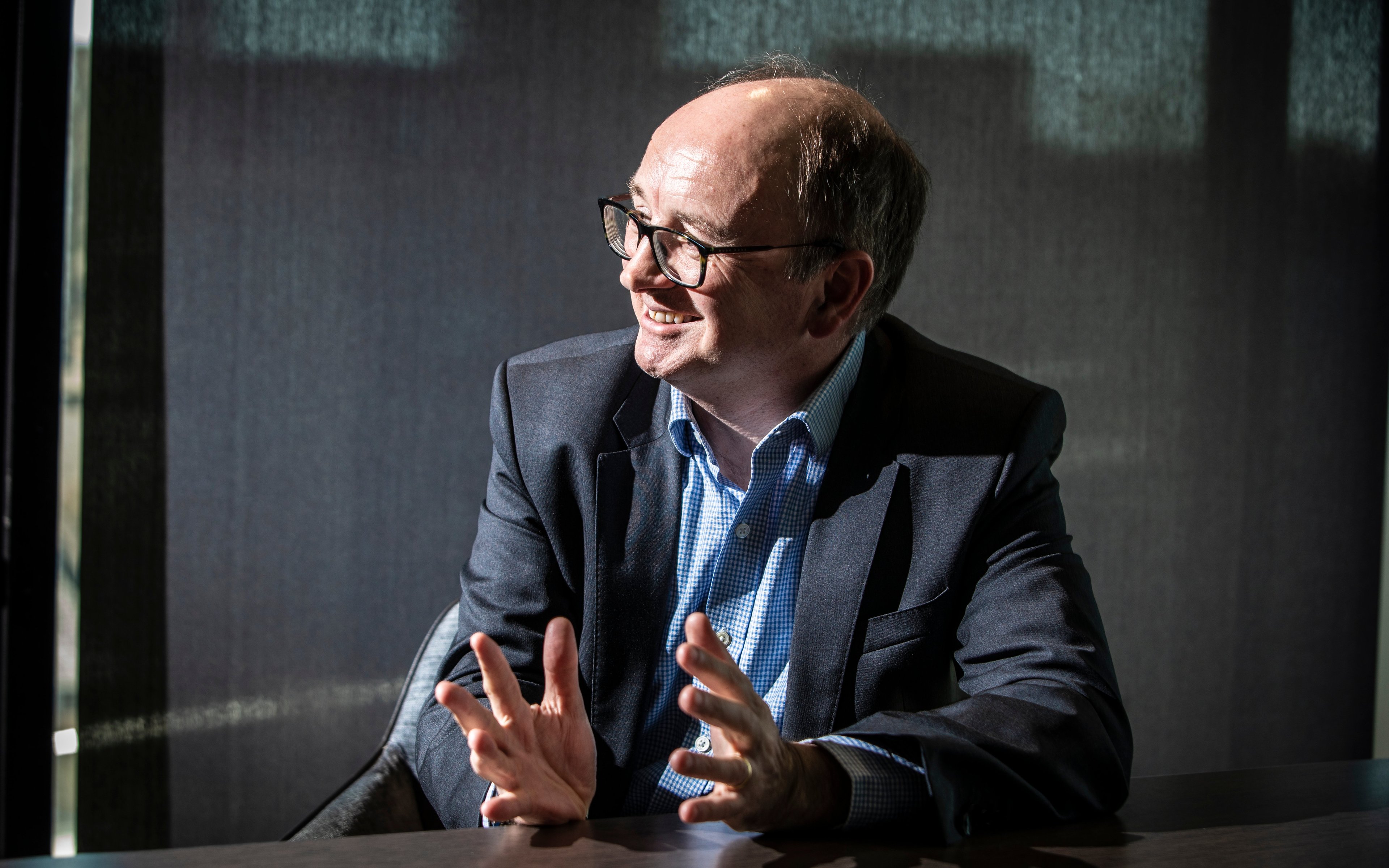
Illustration by Hiroyuki Izutsu
Please remember that the value of an investment can fall and you may not get back the amount invested.
Before Japan was unified under the shogun in the 17th century, it was ruled for centuries by a patchwork of feudal lords. Their reluctance to cooperate and insistence on ancient privileges held back national modernisation and development for generations.
That history comes to mind when Praveen Kumar describes Japan’s “weird” national power infrastructure and the opportunity it presents for electrical company SWCC Showa.
“Japan is one of the few leading industrial countries without a central national grid,” he says. “It’s got this unusual, regionalised setup where the east of the country operates on a different mains frequency from the west.”
It’s a legacy of the country’s adoption of different generator systems from the US and Germany in the late 1800s. In the past, it meant some lights and other electrical equipment would work in Tokyo but not in Osaka.
Nowadays, almost all products can overcome that difficulty, but it still restricts how much electricity can be transmitted around the country. During emergencies or periods of high demand, it’s a problem.
As Kumar describes it, the archipelago’s energy market is divided up between 10 electric power companies, or EPCOs, each with a local monopoly and cosy political connections. The lack of a streamlined, standardised structure was exposed by the 2011 Fukushima nuclear catastrophe, which left some regions lacking power while others had plenty.
Even after that, lobbying and foot-dragging by the EPCOs have left resource-poor Japan badly in need of an infrastructure upgrade. It must accelerate a transition to renewable energy that matches politicians’ rhetoric, meets soaring demand from new sectors, such as AI-related data storage, and trains engineers from an ageing, shrinking population.
“The current system is a nice business for local companies as they control everything from generation to transmission to sales,” says Kumar. “The government is trying to break that up so there can be a more unified system nationwide using state-of-the-art components. That would be good for Japan but not necessarily for the EPCOs, which don’t have much incentive to modernise outdated infrastructure.”
Diamond amid the dull
Kumar discovered SWCC through a magazine article and bought a stake last year after meeting management. He holds the company up as an illustration of how being open to new ideas helps him find undervalued ‘diamonds’ even within Japan’s most stagnant sectors. SWCC’s strategy, he says, is to “focus on the nuts and bolts necessary to allow Japan’s renewable energy revolution to take off”.

Kumar praises the “visionary leadership” of SWCC chief executive Dr Takayo Hasegawa. Before taking charge in 2018, Hasegawa worked in research and development for decades before shattering Japan’s extra-tough glass ceiling to assume the top job.
“I got in touch on the strength of that article, and I’ve since met her a few times,” he says. “With a PhD in superconductivity, she has immense technical knowledge as well as a good focus on return on capital, shareholder returns, etc. Most importantly, she has strong views on how the industry might evolve and is prepared to bet on this through internal changes.”
Kumar credits Hasegawa with spotting an opportunity in the country’s goal of almost halving greenhouse gas emissions by 2030 compared to 2013’s levels and achieving carbon neutrality by 2050. This requires a shift to a ‘smart grid’, which will use software, sensors and smart meters to regulate the supply and demand of energy, resolving the intermittency problems associated with renewables.
Hasegawa has positioned the firm as the handiest supplier of tools essential for this long-term change. These components are the ‘picks and shovels’ of Japan’s infrastructure overhaul and are plugged into the rising demand for data storage capacity and a need for better batteries.
Reducing dependency
The stakes are high. Japan has to import 90 per cent of its energy needs, compared to 41 per cent in the UK and 20 per cent in China. Upgrading and restarting the nuclear power plants shut down after Fukushima has taken longer than planned.
“The Japanese rely on others to keep the lights on,” says Kumar. “They must pay whatever suppliers demand, and disruptions such as Ukraine can send energy bills through the roof.
“Renewables are the biggest opportunity in the long run, as Japanese geography suits them. If the government follows through on its plan to install or increase renewable capacity and people start working in that direction, SWCC’s products and services can play a crucial role. Hasegawa San’s genius lies in exploiting a very real and exciting long-term opportunity.”
Hasegawa has sold off loss-making divisions and cut non-core manufacturing. She consolidated divisions previously isolated from one another and got the research and sales divisions to talk to each other.
She set new performance benchmarks and made division managers accountable for shareholder returns and improved profitability.
Diehard workplace sexism means female leaders are still rare in Japan, especially so in engineering. As well as being a role model, Hasegawa has promoted talented women into decision-making roles.
“Energy infrastructure isn’t something we normally invest in as we don’t see attractive growth companies there,” Kumar says. “But SWCC is a company helping to modernise an entire industry.”
Star product
SWCC’s business model leans heavily on its star product, SICONEX. The family of branded components connects cables to equipment such as switches and transformers in electricity substations, which adjust voltages to ensure the reliable delivery of electricity to businesses and homes.
Its earthquake-resistant connectors are more compact than competitors’ and easier to install. “They’re almost plug and play, like a USB stick,” Kumar comments.
“Hasegawa San has done a fabulous job of turning a traditional electrical cable and wire manufacturer into a fast-growing component provider and consultancy,” he adds.
“With SICONEX, she doubled capacity in an established product that management had failed to push, having identified it as a product that lots of people wanted and no one could copy.
“But the strategy is not just to sell the product. It’s also to train customers on how to install it via augmented reality and other technologies. Adding this consulting element further increases revenue.”

Other key products include e-Ribbon, bundles of ultra-thin, easy-to-install optical fibre, which meets increasing demand from datacentres, and MiDIP, SWCC’s oxygen-free copper wire, largely for use in electric vehicle batteries.
As Kumar describes it, the ‘Hasegawa effect’ exemplifies Baillie Gifford’s belief that individual leaders can transform a business’s culture – and growth prospects.
“We spend lots of time trying to speak with them, understand them and be as supportive as possible because they see opportunity before others,” he explains. “It’s no good if you go after the opportunity that everyone knows about – you’re not going to make any money.”
Risk factors
The views expressed should not be considered as advice or a recommendation to buy, sell or hold a particular investment. They reflect opinion and should not be taken as statements of fact nor should any reliance be placed on them when making investment decisions.
This communication was produced and approved in September 2024 and has not been updated subsequently. It represents views held at the time of writing and may not reflect current thinking.
Investing in private companies could increase risk as these assets may be more difficult to sell, so changes in their prices may be greater.
Potential for profit and loss
All investment strategies have the potential for profit and loss, your or your clients’ capital may be at risk. Past performance is not a guide to future returns.
This communication contains information on investments which does not constitute independent research. Accordingly, it is not subject to the protections afforded to independent research, but is classified as advertising under Art 68 of the Financial Services Act (‘FinSA’) and Baillie Gifford and its staff may have dealt in the investments concerned.
All information is sourced from Baillie Gifford & Co and is current unless otherwise stated.
The images used in this communication are for illustrative purposes only.
Important Information
Baillie Gifford & Co and Baillie Gifford & Co Limited are authorised and regulated by the Financial Conduct Authority (FCA). Baillie Gifford & Co Limited is an Authorised Corporate Director of OEICs.
Baillie Gifford Overseas Limited provides investment management and advisory services to non-UK Professional/Institutional clients only. Baillie Gifford Overseas Limited is wholly owned by Baillie Gifford & Co. Baillie Gifford & Co and Baillie Gifford Overseas Limited are authorised and regulated by the FCA in the UK.
Persons resident or domiciled outside the UK should consult with their professional advisers as to whether they require any governmental or other consents in order to enable them to invest, and with their tax advisers for advice relevant to their own particular circumstances.
Financial Intermediaries
This communication is suitable for use of financial intermediaries. Financial intermediaries are solely responsible for any further distribution and Baillie Gifford takes no responsibility for the reliance on this document by any other person who did not receive this document directly from Baillie Gifford.
Europe
Baillie Gifford Investment Management (Europe) Ltd (BGE) is authorised by the Central Bank of Ireland as an AIFM under the AIFM Regulations and as a UCITS management company under the UCITS Regulation. BGE also has regulatory permissions to perform Individual Portfolio Management activities. BGE provides investment management and advisory services to European (excluding UK) segregated clients. BGE has been appointed as UCITS management company to the following UCITS umbrella company; Baillie Gifford Worldwide Funds plc. BGE is a wholly owned subsidiary of Baillie Gifford Overseas Limited, which is wholly owned by Baillie Gifford & Co. Baillie Gifford Overseas Limited and Baillie Gifford & Co are authorised and regulated in the UK by the Financial Conduct Authority.
China
Baillie Gifford Investment Management (Shanghai) Limited
柏基投资管理(上海)有限公司(‘BGIMS’) is wholly owned by Baillie Gifford Overseas Limited and may provide investment research to the Baillie Gifford Group pursuant to applicable laws. BGIMS is incorporated in Shanghai in the People’s Republic of China (‘PRC’) as a wholly foreign-owned limited liability company with a unified social credit code of 91310000MA1FL6KQ30. BGIMS is a registered Private Fund Manager with the Asset Management Association of China (‘AMAC’) and manages private security investment fund in the PRC, with a registration code of P1071226.
Baillie Gifford Overseas Investment Fund Management (Shanghai) Limited
柏基海外投资基金管理(上海)有限公司(‘BGQS’) is a wholly owned subsidiary of BGIMS incorporated in Shanghai as a limited liability company with its unified social credit code of 91310000MA1FL7JFXQ. BGQS is a registered Private Fund Manager with AMAC with a registration code of P1071708. BGQS has been approved by Shanghai Municipal Financial Regulatory Bureau for the Qualified Domestic Limited Partners (QDLP) Pilot Program, under which it may raise funds from PRC investors for making overseas investments.
Hong Kong
Baillie Gifford Asia (Hong Kong) Limited 柏基亞洲(香港)有限公司 is wholly owned by Baillie Gifford Overseas Limited and holds a Type 1 license from the Securities & Futures Commission of Hong Kong to market and distribute Baillie Gifford’s range of collective investment schemes to professional investors in Hong Kong. Baillie Gifford Asia (Hong Kong) Limited 柏基亞洲(香港)有限公司 can be contacted at Suites 2713-2715, Two International Finance Centre, 8 Finance Street, Central, Hong Kong. Telephone +852 3756 5700.
South Korea
Baillie Gifford Overseas Limited is licensed with the Financial Services Commission in South Korea as a cross border Discretionary Investment Manager and Non-discretionary Investment Adviser.
Japan
Mitsubishi UFJ Baillie Gifford Asset Management Limited (‘MUBGAM’) is a joint venture company between Mitsubishi UFJ Trust & Banking Corporation and Baillie Gifford Overseas Limited. MUBGAM is authorised and regulated by the Financial Conduct Authority.
Australia
Baillie Gifford Overseas Limited (ARBN 118 567 178) is registered as a foreign company under the Corporations Act 2001 (Cth) and holds Foreign Australian Financial Services Licence No 528911. This material is provided to you on the basis that you are a “wholesale client” within the meaning of section 761G of the Corporations Act 2001 (Cth) (“Corporations Act”). Please advise Baillie Gifford Overseas Limited immediately if you are not a wholesale client. In no circumstances may this material be made available to a “retail client” within the meaning of section 761G of the Corporations Act.
This material contains general information only. It does not take into account any person’s objectives, financial situation or needs.
South Africa
Baillie Gifford Overseas Limited is registered as a Foreign Financial Services Provider with the Financial Sector Conduct Authority in South Africa.
North America
Baillie Gifford International LLC is wholly owned by Baillie Gifford Overseas Limited; it was formed in Delaware in 2005 and is registered with the SEC. It is the legal entity through which Baillie Gifford Overseas Limited provides client service and marketing functions in North America. Baillie Gifford Overseas Limited is registered with the SEC in the United States of America.
The Manager is not resident in Canada, its head office and principal place of business is in Edinburgh, Scotland. Baillie Gifford Overseas Limited is regulated in Canada as a portfolio manager and exempt market dealer with the Ontario Securities Commission ('OSC'). Its portfolio manager licence is currently passported into Alberta, Quebec, Saskatchewan, Manitoba and Newfoundland & Labrador whereas the exempt market dealer licence is passported across all Canadian provinces and territories. Baillie Gifford International LLC is regulated by the OSC as an exempt market and its licence is passported across all Canadian provinces and territories. Baillie Gifford Investment Management (Europe) Limited (‘BGE’) relies on the International Investment Fund Manager Exemption in the provinces of Ontario and Quebec.
Israel
Baillie Gifford Overseas is not licensed under Israel’s Regulation of Investment Advising, Investment Marketing and Portfolio Management Law, 5755-1995 (the Advice Law) and does not carry insurance pursuant to the Advice Law. This material is only intended for those categories of Israeli residents who are qualified clients listed on the First Addendum to the Advice Law.
115432 10049507





